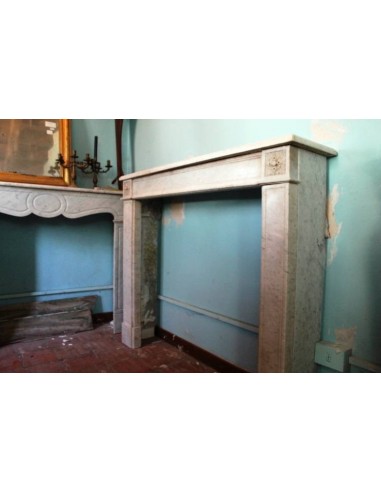ANTIQUE LOUIS XVI MANTEL IN WHITE CARRARA MARBLE, WORK MADE IN THE LAST QUARTER OF THE EIGHTEENTH CENTURY AND BEFORE 1790, EXCELLENT PRESERVATION, PROVENANCE PARIS, ITALIAN SCULPTURE.
IMPORTANT WARNING:
THE FIREPLACE MANTEL YOU SEE IN THE LAST PICTURE ON THE RIGHT BELOW IS NOT THE FIREPLACE I AM PRESENTING HERE, BUT RATHER... HIS SON (This is a Louis XVI “Two Flowers” built in the Napoleon III era and available to us...).
YOU WILL UNDERSTAND WHY I WROTE ABOVE IF YOU HAVE THE PATIENCE TO READ THE COMMENTARY I WILL WRITE BELOW, EVEN THOUGH IT PROMISES TO BE AS LONG AS A NOVEL.
It is when I have to write comments like this that I am seized by deep bouts of melancholy, or rather, by a feeling of disillusionment with respect to the hopes I cherished when, almost forty years ago, I began my (wonderful, in spite of everything, I would start again right away...) adventure among the ancient fireplaces.
Those were the 1970s, years still imbued, at least in young men like me, with great hopes in the cultural progress of all Humanity, even the Italians...
And so, when in July 77, after I quit my job at the construction company I worked for, I bought the first three antique fireplaces to begin this (for many strange) trade, the situation in this area was more or less this:
1) Antique fireplaces were bought by almost no one (except for the Big Ducks like Berlusconi and Ferrero, people who certainly didn't come to my poor warehouse, they all went to Via della Spiga in Milan or Via De' Coronari in Rome to emblazoned antique dealers, the ones with regular moustache, strictly cashmere jacket and Louis Vuitton scarf around their necks even in the mid-August)
2) The “people” (i.e., those like me and you who are reading me) bought only one type of fireplace, imagining that there were no others, and this prevailing “model” was, no more and no less, what I call “The Flingstones fireplace”..... the ANTHONYRS Fred AND Wilma from the cartoon series of the same name, remember? It was, in short, the classic tavern fireplace, all exposed brick and embossed wooden beams from a hatchet...
Faced with such a market, anyone would have thought that I was a fool to throw myself into it, and that what two liras (my mother's janitor's savings..) I had at my disposal would be lost quickly and surely...
But I was certain that, sooner or later, the Italians would understand how much difference there was between an antique fireplace mantel (carved by hand and polished with sweat and pumice stone) and a fireplace spit out by an automatic machine and then polished with an equally automatic brushing machine..
“My” fireplace had history and art inside and out while the industrial one was a thing of no value, neither craft nor art-how could I have ever lost such a bet!
Well, almost forty years later, although I too have had my satisfactions, I can give this bet more lost than won.. True, some have abandoned the “basement” type fireplace to perhaps give themselves to hypermodern steel fireplaces, thus falling from the frying pan into the embers, but the majority of Italians still prefer the “industrial” fireplace, the one proposed by large companies through catalogs in which the names of the fireplaces are impersonal acronyms (e.g., “Look, ma'am, how beautiful is our model K834 ! !") and the proposed fireplaces come, for the overwhelming majority, from China, Pakistan or India (poor Italy, and poor me who believed in you!!).
The antique fireplace covers perhaps three/four percent of the specimens sold (which is still better than the 0.0007 of forty years ago, but hardly a great result..), this is today's Italian reality, far from other situations in European countries more acculturated than ours.
WHY AM I TELLING YOU ABOUT THESE THINGS WHEN I SHOULD BE TELLING YOU ABOUT THE FIREPLACE PUBLISHED ABOVE?
Because, unfortunately, even among lovers of antiques there is a preference for the “modern.”
Let me explain further:
The fireplace presented here is a “period Louis XVI fireplace,” that is, built during the period when Louis XVI reigned (thus in the last quarter of the 18th century)..
In contrast, the Louis XVI fireplace mantel portrayed in the fourth photograph in this presentation is an antique specimen yes, but built in the Napoleon III period (basically in the second half of the nineteenth century).
Both of them bear the same “nickname,” they are in fact both called “Louis XVI Deux Fleurs,” they are closely related and that is why the older one I have referred to it as the daddy of the newer one
WELL, ONE WOULD THINK THAT THE OLDER ONE, WITH EQUAL PRESERVATION, SHOULD BE WORTH MUCH, MUCH MORE, THAN THE SECOND ONE, IF ONLY BECAUSE OF ITS FAR MORE DIFFICULT FINDING
NOT SO, “MODERN” CUSTOMERS (NOT ALL, BUT MANY...) PREFER THE NAPOLEON III FIREPLACE TO THE ONLY SEEMINGLY “SIMPLER” EIGHTEENTH-CENTURY-ERA ONE, WITH COMPARATIVELY HIGHER PRICES FOR THE SON THAN THE FATHER...
In short, I will depart from this world without having the satisfaction of being able to say that Italians, on the strength of their centuries-old culture, are true connoisseurs of art, I will die without being able to proudly say that my countrymen, children of the Renaissance, have in their chromosomes the ability to understand, better than any other people on the globe, where the most beautiful and the most artistic lies.
IT'S DISHEARTENING, BUT (AND HERE YOU'LL HAVE TO TAKE MY WORD FOR IT ...) I CAN GUARANTEE YOU THAT MANY RUSSIAN (OR AT ANY RATE EASTERN, OF THOSE PARTS THERE, IN SHORT ...) CLIENTS HAVE A FINESSE OF TASTE THAT I FIND MORE AND MORE DIFFICULT TO FIND IN OUR OWN CLIENTELE.
IN A NUTSHELL, IF YOU BETRAY ME TOO, MY DEAR FEW AND AFFECTIONATE CHARCOAL LOVERS OF THE ANTIQUE FIREPLACE, WHAT BALANCE SHEET SHOULD I MAKE OF MY LIFE'S WORK!


























































